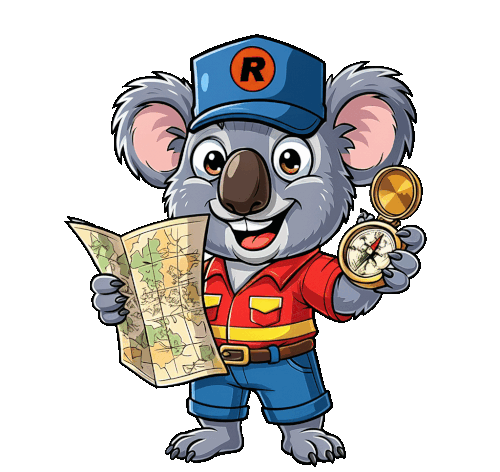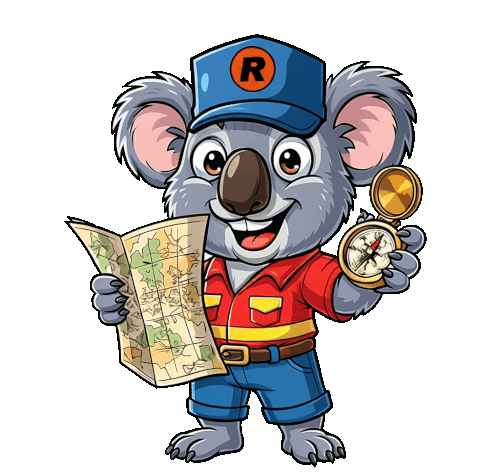The Skills
Rogaining is often called “The Sport of Thought”, because you develop a lot of skills rogaining, most of them unrelated to how fit you are:
It is these skills, when combined with the exploration of new areas and the beauty of the bush that keeps experienced rogainers coming back.
Rogaining is easy to learn, but hard to master. Keep reading below as I discuss the basics of some of these skills.
Navigation Skills
If there’s one thing regular rogaining will improve, it’s your navigation. Many participants are drawn to the sport specifically to develop stronger map reading and compass skills—and rogaining delivers.
From the moment you begin planning your route to the time you’re out on the course, navigation is front and centre. Reading the map, interpreting terrain, and making efficient decisions between checkpoints are constant challenges. Compass use is essential—but also easy to learn with practice.
The optimal route is rarely a straight line. Navigational techniques vary depending on conditions: day or night, steep or flat, open or thick bush. Skilled rogainers know how to adjust their strategies accordingly.
A key ability to develop is maintaining map contact—being able to pinpoint your location on the map at all times. This helps avoid getting off-track and allows for quick adjustments when things don’t go as planned.
At some point, every team will find a control isn’t where they expected. That’s when relocation skills—interpreting the terrain, reassessing the surroundings, and regaining map contact—become critical. Doing this effectively, especially in the early hours of the morning, is a hallmark of experienced teams.
Rogaining isn’t just about speed. In fact, it’s often the carefully navigating “tortoises” who outperform the faster but less precise “hares”. Well-planned routes and accurate navigation consistently outscore raw physical speed.

Compass Basics
Check out the video below. Steve Blackshall shows how to use a compass. Note that in the video Steve adjust between grid and magnetic north. Rogaining maps all show magnetic north so this adjustment is not needed.
Route Planning
Before the event starts, teams usually receive their maps up to two hours in advance. This time is set aside for planning your route. Since you can visit the checkpoints (called controls) in any order, the aim is to create a strategy that helps your team earn the highest possible score while staying within everyone’s physical limits.
To plan well, it’s important to be able to read and understand a topographic map, especially in unfamiliar terrain. Good route planning involves deciding which checkpoints to visit first, which ones to leave for later, and which to tackle during the day or at night. You’ll also want to think about backup options: extra checkpoints to add if you’re ahead of schedule, or ones you can skip if you’re running behind. You might even consider whether it’s practical to return to the Hash House (event base) during the event for a rest or a hot meal.
Experienced teams use this planning time to explore multiple route options, estimate distances and travel times, and set realistic goals. They know how their pace changes depending on terrain and how they typically perform at different stages of the event. Before starting, each team must submit a “flight plan” — a rough outline of their intended route — which helps event organisers in case a team gets delayed or lost.
Here are some helpful steps for route planning:
Highlight high-scoring checkpoints and look for clusters that offer good point value.
Study the map to get a feel for the distances and elevation changes.
Create small sequences of checkpoints that seem efficient and rewarding.
Link these sequences together to form your full course.
Mark your route clearly on the map, including your safety plan.
Estimate where your team should be at each hour (e.g., after 1, 2, 3, and 4 hours) to track your progress.
Course setters often suggest one or more “Novice Routes” on the map. These are great starting points. You can add or remove checkpoints from them based on how far you think your team can travel comfortably.
Route Planning in Action
Check out the video below. In this video you can see that many competitors for this event plan using drawing pins. Drawing pins are placed on controls and a string run between controls to measure the distance of a proposed route. This is commonly known as “stringing” a course.
Teamwork
Teamwork is at the heart of rogaining and one of the most rewarding parts of the sport. All members of a team must stay together at all times, which means communicating well, making joint decisions, and supporting each other physically and mentally throughout the event.
Before the event, discuss expectations, fitness levels, navigation experience, and how decisions will be made. During the event, keep talking—check in regularly about pace, hunger, fatigue, or any concerns. Stronger navigators can lead the way, but it’s important everyone understands the route and is involved in decisions. All rogainers should stay in touch with where they are on the map so they can help catch navigational errors before a lot of time is wasted going in the wrong direction.
Be flexible and supportive. One team member might have a tough patch; another might need to slow down or take a break. Encourage each other, share the load (such as navigation, route replanning and pace counting), and stay patient. Problems are more easily solved when everyone feels respected and heard.
Good teamwork also means being prepared to change the plan if needed—dropping controls, resting, or heading back early are valid options if it keeps the team safe and positive.
Rogaining is not just about points; it’s about working together and enjoying the challenge as a team. Many people say the friendships built on the course are the best part of the sport.
Dealing with Fatigue
Fatigue is a key challenge in rogaining, especially during longer events, and managing it well is essential for a safe and enjoyable experience. Start by pacing yourself—avoid setting off too fast, even if you’re feeling fresh. It’s important to conserve energy for the later stages of the event. Build regular breaks into your plan to rest, eat, and hydrate. Your body needs fuel to perform, so carry high-energy snacks and drink water frequently, even if you’re not feeling thirsty.
Fatigue isn’t just physical—it can affect your concentration and decision-making. If you or a teammate starts making navigation errors, losing motivation, or showing signs of confusion, it might be time for a longer break. Use this time to eat, stretch, and reset your focus. Share the navigation duties among team members to share the mental load.
Keep an eye on each other and communicate honestly about how you’re feeling. Sometimes it’s better to adjust your plan—skip a few controls or take a longer rest—rather than push through and risk exhaustion. If the course allows, planning a return to the Hash House during the event for a hot meal and mental recharge can make a big difference.
Most importantly, support your teammates and stay positive—rogaining is a team effort, and mindset matters.
Reading a Map
The video below shows the basic skills in reading a map.
The scale of the maps used in rogaines varies, but 1:25 000 (4cm to a km) or 1:20 000 (5cm to a km) are common.
Contour lines typically denote a 10m change in elevation although 5 m and 20 m contours lines are also used occasionally.
Also remember that rogaining maps have magnetic north lines marked on them, so there is no need to adjust between Grid North and Magnetic North.
